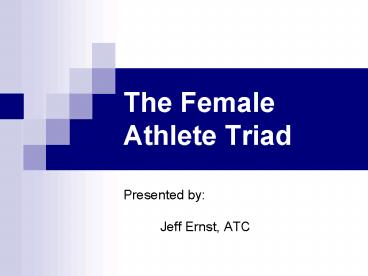The Female Athlete Triad - PowerPoint PPT Presentation
1 / 24
Title:
The Female Athlete Triad
Description:
Osteopenia: BMD between 1 and 2.5 SD below the mean for young adults. ... Disordered Eating: 1% - 62% depending on population studied. ... – PowerPoint PPT presentation
Number of Views:1362
Avg rating:3.0/5.0
Title: The Female Athlete Triad
1
The Female Athlete Triad
- Presented by
- Jeff Ernst, ATC
2
The following articles were used as the main
backbone in the creation of this presentation
- Beals KA Female Athlete Triad Update. Clin
Sports Med 26 (2007) - Otis CL, Drinkwater B, Johnson M, et al. ACSM
Position Stand The Female Athlete Triad. Med Sci
Sports Exerc 29 (1997)
3
What is the Female Athlete Triad?
- 1997 American College of Sports Medicine (ACSM)
Definition - Disordered Eating
- Amenorrhea
- Osteoporosis
4
1997 ACSM Definition Disordered Eating
- Wide spectrum of harmful or ineffective eating
behaviors used in attempts to lose weight. - Ranges in severity from restrictive eating to the
DSM-IV defined eating disorders.
5
1997 ACSM Definition Amenorrhea
- Primary amenorrhea is the absence of menstruation
by the age of sixteen in a female with secondary
sex characteristics. - Secondary amenorrhea is the absence of three or
more consecutive menstrual cycles after menarche.
6
1997 ACSM Definition Osteoporosis
- Disease characterized by low bone mass and
micro-architectural deterioration of bone tissue. - Follows World Health Organization (WHO)
diagnostic criteria.
7
World Health Organization (WHO) Diagnostic
Criteria
- Normal bone mineral density (BMD) that is no
more than 1 standard deviation (SD) below the
mean of young adults. - Osteopenia BMD between 1 and 2.5 SD below the
mean for young adults. - Osteoporosis BMD more than 2.5 SD below the mean
for young adults.
8
The Female Athlete Triad Today
- 2007 ACSM Definition
- Disordered Eating
- Menstrual Dysfunction
- Low Bone Mineral Density (BMD)
9
2007 ACSM Definition Disordered Eating
- Increased emphasis on energy availability.
- Defined as the amount of dietary energy remaining
for all other physiologic functions after energy
has been expended in exercise. - Commonly occurs with poor food choices and
increasing activity levels without increased
caloric intake.
10
2007 ACSM Definition Menstrual Dysfunction
- Includes the full spectrum of menstrual
irregularities. - Greater emphasis placed on luteal suppression,
anovulation, oligomenorrhea, along with both
primary and secondary amenorrhea.
11
Luteal Suppression
- Also called luteal phase deficiency.
- Generally asymptomatic.
- Shortened luteal phase (between ovulation and
menstruation). - May be accompanied by prolonged follicular phase
resulting in little change in cycle length.
12
Anovulation
- Absence of ovulation.
- Generally caused by impairment of follicular
development resulting from altered hormonal
status. Enough estrogen is present to stimulate
some proliferation of the uterine lining
resulting in slight bleeding. - Due to the bleeding, many females believe they
are not suffering from menstrual irregularities.
13
Oligomenorrhea
- Irregular menses.
- Used to describe a prolonged length of time
between cycles. - 35 or more days between cycles.
14
Amenorrhea
- Primary amenorrhea has been redefined by the
American Society of Reproductive Medicine as the
absence of menstruation by the age of 15 in
females with secondary sex characteristics. - Secondary amenorrhea continues to be defined as
the absence of three or more consecutive
menstrual cycles after menarche.
15
2007 ACSM Definition Low Bone Mineral Density
- Emphasis has been placed on the full spectrum of
bone health. - Spans from low bone mineral density and stress
fractures to osteoporosis.
16
Why the Change?
- Greater emphasis on the full spectrum of
behaviors and conditions within a given disorder. - The original version focused more on the extreme
end point of each disorder.
17
How Are They Interrelated?
- Disordered eating and menstrual dysfunction.
- Disordered eating and low bone mineral density.
- Menstrual dysfunction and low bone mineral
density.
18
Prevalence
- Disordered Eating 1 - 62 depending on
population studied. More prevalent in sports
that emphasize lean physique. - Menstrual Dysfunction 6 - 79 depending on
definitions used in study. - Low Bone Mineral Density 22 - 50 (mainly
osteopenia).
19
Prevalence of the Triad
- The prevalence of all three components
simultaneously 0 - 2.2. - Although rare, any occurrence should warrant
concern with the healthcare provider.
20
Warning Signs
- Ritualized eating
- Food restriction
- Chronic dieting
- Skipping meals
- Fasting
- Laxative use
- Diet pill use
- Obsessive training
- Low self-esteem
- Dry skin and hair
- Constipation
- Chronic diarrhea
- Frequent weight fluctuations
- Fatigue
- Muscle weakness
- Muscle cramps
- Dehydration
- Delayed puberty
- Frequent restroom visits after meals
21
Evaluation Options
- History Questionnaire (easy and effective)
- Blood Tests (measure ovarian steroid hormone)
- Dual Energy X-ray Absorptiometry (DXA)
22
Treatment Options
- Educate
- Correct energy deficit
- Increase calories by 10 per week until target is
reached. - Decrease activity levels to assist in correcting
energy deficit. - Limit weight gain to 1-2 pounds per week.
23
Treatment Options Continued
- Oral Contraceptives
- Regulates hormones.
- Assists in normalizing menstrual cycle.
- Assists in increasing bone mineral density?
- Vitamin D and calcium supplementation.
24
- THANK YOU































